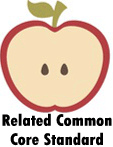Singular Possessive Nouns Worksheets
Related ELA Standard: L.1.1.B-D

In modern society we often respect the belongings of others a little more than our own, if we have good manners. Many times it is helpful to understand what belongs to who. When writing nouns in the possessive form we usually add the letter "s" after we add an apostrophe. Just because we add the letter "s” does not mean that it is a plural word, it still can be singular. This apostrophe and the letter "s" helps an author signify a level of ownership of the noun they are directed at. There are degrees to ownership that we must be aware of. This form can be used to demonstrate who a phone belongs to or it can also be used to indicate a look on the face of a person. The worksheets found below work on using the singular form of possession with nouns.
Singular Possessive Noun Worksheets:
Combining Sentences - Read each pair of sentences. Then combine them to create one sentence, using a singular possessive noun.
What Owns You? - Write the correct form of the noun to show what belongs to whom. These are shorter sentences to work with.
That Belongs To Me! - Write your thoughts in a manner that shows who owns each belonging. Follow the example.
Making Singular Nouns - Write an original sentence that uses all of the different terms that are given to you. In your sentence, turn you make an adjustment to the part of speech used.
Mark the Spot! - Read each sentence below. If the possessive noun in the sentence is correct, put a check on the line.
Under the Lines - Evaluate each of your choices to complete the sentences. Underline the correct possessive noun. Rewrite the sentence on the line.
It's Possessed - Rewrite each sentence to include a sense of ownership for the object or subject. The use of objects is appropriate and makes sense.
Sentence Fills - Write the possessive form of the noun in parentheses to show belonging. Also feel free to add articles where they may be needed.
Sentence Combos - Combine the two sentences to make one connective and concrete thought. You may need to make a shift in a part of speech along the way.
Question That - Write a sentence that uses each of the words that you are given. In your sentence, make the noun show who it belongs to.
Finish That Sentence - It only takes a word or two. You will need to make adjustments to words in these sentences.
Make Them One - Read the two sentences. Then combine them by filling in the two blanks with the correct possessive noun and a common noun.
Correctness - This will require quite a number of words that you will extract from the sentences in front of you.
Bad Example - Find the error in each sentence. You will then need to write a correction for a term in the sentence on each of the lines.
What Are Singular Possessive Nouns?
Nouns are naming words. There are several different types of them. A possessive noun is one such type. Singular possessive nouns show a sense of possession and ownership. They show that a certain thing belongs to a singular noun. Whereas, a plural forms shows the opposite of this. Plurals show that the possession belongs to a number of nouns.
How to recognize a singular possessive noun
You can easily detect a singular possessive noun in a sentence or paragraph. All you have to do is look for an apostrophe. If there is an apostrophe on a noun, it means that it is a possessive noun. An apostrophe depicts the element of possession and ownership. That is the reason why it is used with these words.
Here are some examples of singular possessive nouns:
The teacher's glasses broke into pieces.
Children were looking at the Uncle's shiny new car.
The kitten's eyes were shining like marbles.
How to convert a regular form into a singular possessive form
It is very easy to convert a regular noun into a singular possessive noun. There are certain grammatical rules that need to be followed for that. The process for doing that is not very tough or hard. You will only need to remember a simple rule to do so.
If you want to show some sort of possession or ownership for the noun in a sentence, then you can simply follow the grammatical rule in the right order. All you have to do is to add an apostrophe at the end of the word. Along with the apostrophe, you will also have to add an "s".
For example,
James's pen
Sasha's wardrobe
Dog's food

